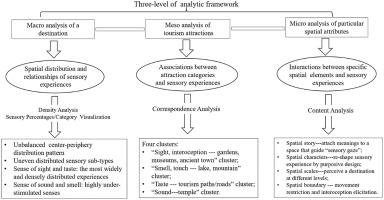Tourism Management ( IF 12.7 ) Pub Date : 2023-01-19 , DOI: 10.1016/j.tourman.2023.104723 Huahua Li , Mimi Li , Huixia Zou , Yi Zhang , Jingjing Cao

|
Tourism sensory experiences represent a spatially constrained and constructed process influenced by various environmental stimuli. Although growing academic attention has been devoted to sensory tourism, few studies have incorporated spatiality into investigations of sensory experiences. This study establishes a macro–meso–micro analytical framework to explore the relationships among sensory experiences and spatial environmental characteristics based on social media big data. This research also moves beyond the conventional five-sense framework to include a sixth sense—interoception. Results (a) uncover the spatial distribution and relationships among sensory experiences in a destination; (b) demonstrate associations between attraction types and sensory experiences; and (c) illustrate interactions between environmental attributes and sensory encounters. This study theoretically clarifies relevant antecedents, extends a sense-based framework, and multidimensionally enriches tourism sensory experiences; empirically offer guidance for sensory environment planning, marketing, and management. Results also produce methodological insights for adopting social media big data to capture sensory experiences.
中文翻译:

城市感官地图:游客如何在空间上“感知”目的地?
旅游感官体验代表了受各种环境刺激影响的空间受限和建构过程。尽管学术界越来越多地关注感官旅游,但很少有研究将空间性纳入感官体验的调查。本研究建立了一个宏观-中观-微观分析框架,以探索基于社交媒体大数据的感官体验与空间环境特征之间的关系。这项研究还超越了传统的五感框架,包括第六感——内感受。结果 (a) 揭示目的地感官体验之间的空间分布和关系;(b) 证明吸引力类型和感官体验之间的关联;(c) 说明环境属性和感官接触之间的相互作用。本研究从理论上厘清相关前因,拓展感官框架,多维丰富旅游感官体验;根据经验为感官环境规划、营销和管理提供指导。结果还产生了采用社交媒体大数据来捕捉感官体验的方法论见解。


























 京公网安备 11010802027423号
京公网安备 11010802027423号